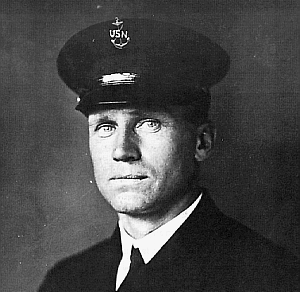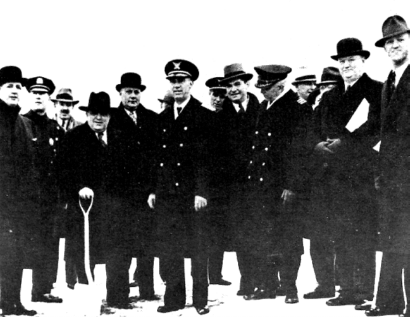
Floyd Bennett
The story of Floyd Bennett Field, from garbage heap and glue factory, to municipal airport, to Naval Air Station, was a saga of continual controversy, progress, and achievement unmatched in aviation history.
On February 3, 1928, the decision to build a municipal airport was made. Up until this time, New York did not have an airport, with LaGuardia and Kennedy Airports to come later. Newark, N. J. Airport was fast becoming the world' s busiest airport with most cargo and passengers destined for New York.
Aviator Clarence D. Chamberlin was commissioned to chose a site for the new airport. The site he chose was Barren Island, a 387 acre marsh with 33 small islands located in Jamaica Bay on the southern tip of Brooklyn. He chose this site because of it' s complete lack of obstructions and it being easy to locate from the air. After much controversy and debate, the site was approved.
Six million cubic yards of sand were pumped from Jamaica Bay to connect the islands and raise the site to 16 feet above the high tide mark.
There was no debate as to what to name the field. Floyd Bennett, born in Warrensburg, N.Y., had lived in Brooklyn and had been New York's favorite aviator. He enlisted into the Navy for flight training in 1917. Winning his wings, Bennett first served as a test pilot and later as a Chief Machinists Mate aboard the U.S.S. Richmond, in charge of aircraft.

Floyd Bennett
It was while aboard the U. S. S. Richmond that Bennett met Admiral Richard E. Byrd. In 1925, he accompanied Byrd on the MacMillan Expedition to the Arctic. On May 9, 1926, Byrd and Bennett took off and made history by being the first men to fly over the North Pole. For this feat, both men were awarded the Congressional Medal of Honor. Plans were being made for a second trip, this time to the South Pole. Bennett did not live to realize the triumph of the South Pole Expedition. In April 1928, while suffering a high fever, he heard of the flight of Irish-German crew of the ' Bremen', which was forced down at Greenley Island, Quebec, on an attempted non-stop flight from Europe. Bennett was not acquainted with any ofthe pilots on board the 'Bremen', but they were fellow fliers and explorers in trouble, and despite his fever, he took off immediately from Detroit to try a rescue.
At Murray Bay, he was stricken with influenza, but refused to turn back. Halfway on his journey across Canada, Bennett died of pneumonia. Floyd Bennett was buried at Arlington National Cemetery, Virginia. Out of respect for Bennett, Admiral Byrd took a stone from Bennett' s grave and dropped it over the South Pole on the flight that he and Bennett had planned together.
The City of New York spared no expense on the field, as they were trying to convince the U. S. Postal Service to designate the field an Official Airmail Terminal. A seaplane base was built on the southern waterfront and sections of Flatbush Avenue were rerouted and widened to create a more direct route for trucking mail to Manhattan.
Dedication ceremonies for the formal opening of the field were held on May 23, 1931 and were attended by 15,000 people. An air parade, with stunt flying by Army and Navy planes, highlighted the activities. Later, amid much publicity, Admiral Byrd, Mayor Walker and his wife, and Mrs. Floyd Bennett arrived for the dedication of Floyd Bennett Field.
Much feuding went on between the City of New York and Newark about moving the Eastern Mail Terminal from Newark to Floyd Bennett Field. On March 22,1936, the crushing blow came. The U.S. Postal Service rejected Floyd Bennett Field's application for the Air Terminal. New York City slowly turned it' s attention to the new LaGuardia Field which was much more convenient than either Newark or Floyd Bennett Field.
From 1931 to 1941, the field attracted many daredevils. Many flights originated from the field to include Trans-Atlantic, Trans-Continental, around the world, and many other record breaking flights. Some of the more famous pilots to originate their flights from the field were Wiley Post, Howard Hughes, Amelia Earhart, Roscoe Turner, Laura Ingalls, Jimmy Doolittle, Jacqueline Cochran and Douglas "Wrongway" Corrigan.
On January 22,1936, Mayor LaGuardia announced that the City of New York had executed a 50 year lease to the U. S. Coast Guard for facilities at the field. The Coast Guard was to occupy 9.7 acres (650 ft. X 650 ft.) on Jamaica Bay and construct a $250,000 base. On April 23, 1938, The Coast Guard Air Station, Floyd Bennett Field was established.

Mayor LaGuardia (w/ shovel) and Rear Admiral R.R. Waesche, Commandant, USCG (center) at ground breaking ceremonies for the air station.
On May 22,1941, the U. S. Navy leased Floyd Bennett Field from the City of New York. By May 26, all private and commercial flying at the field was discontinued. On June 2, Naval Air Station, Floyd Bennett Field, N. Y. was commissioned. The City of New York ceded exclusive jurisdiction over Naval Air Station, N.Y. to the Navy Department on Sentember 28. 1943.
The field was very active during World War II. The field was expanded in size from 387 acres to 1288 acres by reclaiming large portions of Barren Island.
Several miles of roads were added, long concrete runways were installed, plus facilities for beaching large Navy flying boats. A $600,000 hangar was built for hous- ing these flying boats. By February 1945, the Naval Air Station had commissioned it' s 20,000th aircraft for the war effort.
Floyd Bennett Field remained busy during the Korean War and Vietnam. During these times, the Navy and Marine Corps used the field for their Reserve Squadrons. In 1971, the Naval Air Station was decommissioned. The field was turned over to the Interior Department for inclusion into the Gateway National Recreation Area. The Coast Guard and New York City Police Aviation Unit are all that are left flying at the field and they are restricted to helicopters. All that remains of what was once a bustling part of the aviation community are the abandoned hangars that housed so many of the record-breaking aircraft. On a quiet night, with a little imagination, you could probably hear Wiley Post thundering down the runway, off on another record-breaking flight or the thousands of Navy fighters and bombers off to the war.